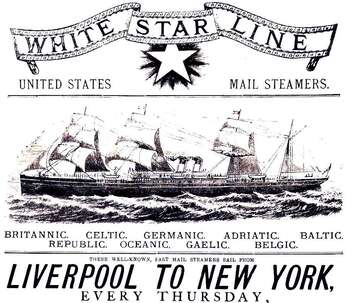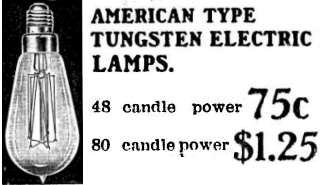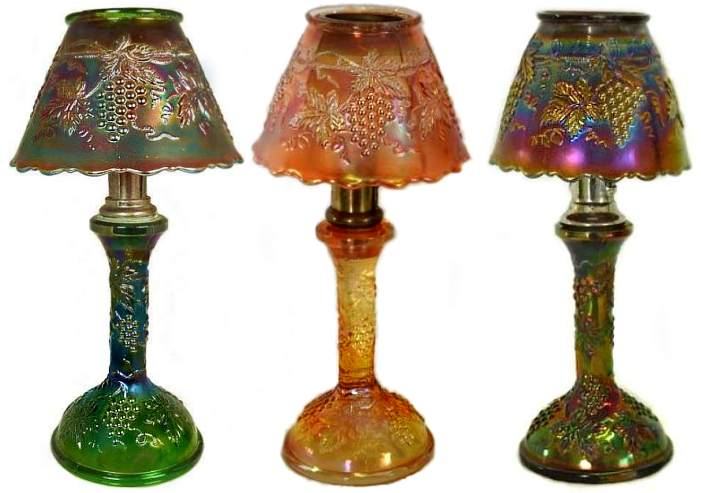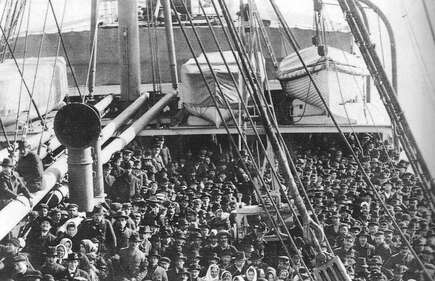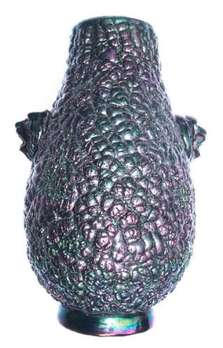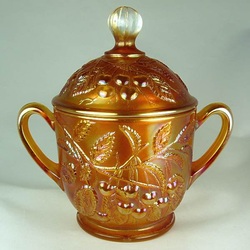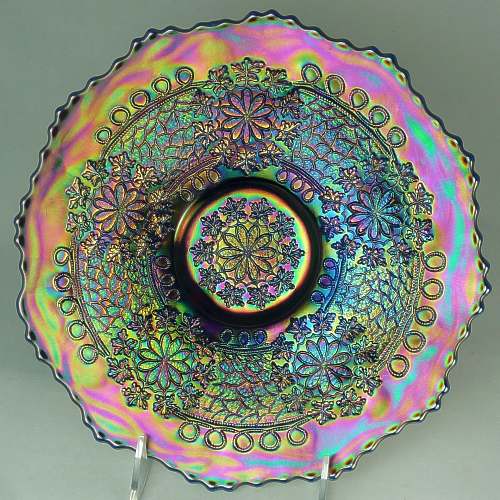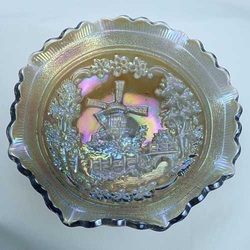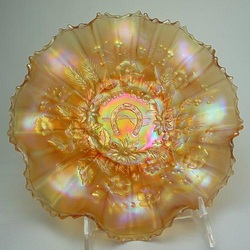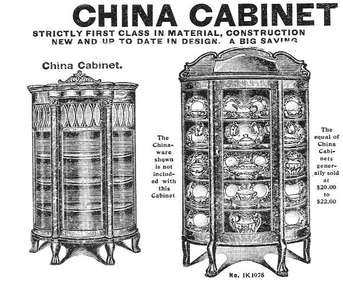Glass for its time ..... and made to sell!
So, why did Carnival Glass come about in the first place? What exactly was the social and design context, what inspired it and why did it flourish? Two words will sum it all up—it’s complicated! What was it like back in the early 1900s, at the advent of Carnival Glass?
|
In the home, the tungsten light bulb was just becoming available, though candles and oil lamps were still in use. The vacuum cleaner had just been launched. Kellogg’s Corn Flakes were the new de-rigueur breakfast; Coca-Cola, Pepsi and Jell-O were the new food fads and the pizza had just hit the New York food scene. |
Although there were still many indications of a more difficult past, things were definitely changing. Advances in transportation made the movement of raw materials and goods so much easier, facilitating the growth of industry.
Transportation by sea had brought millions of people into the United States from other parts of the world. The ad for White Star Line on the left says it all: the names of the ships (Britannic, Celtic, Germanic and so on) give a very good indication where many of the people were coming from, as immigrants had flocked in, carried by regular sailings by steamships and the great ocean-going liners.
Transportation by sea had brought millions of people into the United States from other parts of the world. The ad for White Star Line on the left says it all: the names of the ships (Britannic, Celtic, Germanic and so on) give a very good indication where many of the people were coming from, as immigrants had flocked in, carried by regular sailings by steamships and the great ocean-going liners.
|
It was arguably the biggest movement of population ever to take place. By 1900 an estimated thirty-five million had arrived from much of the civilized world, principally Europe, bringing skills and ideas. This was the melting pot of new concepts, advancement, growth, change and challenge from which Carnival Glass emerged. The picture on the right show a tiny part of the tide of humanity that arrived at Ellis Island seeking a new life in the USA. They included an amazing array of skilled tradespeople - which we know included glassworkers from Europe. The genesis of Carnival Glass came at a time of changing fashion in art and design. So—what exactly inspired Carnival Glass? Where do we look for the inspiration behind the desire to use iridescence? And where do we look for the background to the multitude of patterns seen on Carnival? To answer these questions we must cast our net wide, for Carnival Glass was like a mirror, reflecting all the changing fashions and trends. Its style was truly eclectic—borrowing freely from various sources—a conflation of all the different popular tastes. |
|
Iridescence on Glass
The first actual (and intentional) use of iridescence on glass that we can be reasonably certain of, was in Bohemia in 1856: the concept was developed and iridescent glass took off. The "Father of Iridescence on Glass" was Leo Valentin Pantocsek who, in around 1856, created a technique for iridising glass. Later, Josef and Ludwig Lobmeyr, the renowned Viennese glassmakers, spotted the business opportunities in iridised glass, and the techniques spread around Europe and beyond. In England, Thomas Webb and Sons made great use of iridescence on their glass (as shown on the left), and Tiffany also capitalised on it, devoting much of his energy towards producing and distributing decorative arts destined to transform the interiors of homes of wealthy buyers everywhere. It was high fashion—and expensive. In fact, it would have taken the average worker almost two months’ wages to buy a Tiffany vase. Into this arena came a mass-produced version of fancy iridised glass—what we know today as Carnival Glass. The availability of this inexpensive glassware that emulated the splendid Tiffany iridescence and also boasted rich and decorative patterns, was bound to please the buying public. The wholesale price of a dozen iridised vases from manufacturers such as the Fenton Art Glass Company, was less than a dollar! In this way, Carnival Glass took the market. In fact, in some circles it began to be called “poor man’s Tiffany.” The development and spread of making iridescent glass is explored in full here: Iridescence is the heart and soul of Carnival Glass. |
Carnival by Design
What of its design context? Carnival boasts a century long legacy that reflects its eclectic design. It drew inspiration from styles such as Arts & Crafts, Orientalism, Art Nouveau and Art Deco. The Carnival makers wanted to make glass that would SELL. So they looked to popular design ideas and motifs of the day that had themselves been influenced by those styles—especially those that were seen on household items such as wallpapers, tiles, textiles, fabrics and even chic magazine covers (“Vogue” and “Life” for example), as well as iridised art glass like that made by Tiffany. And they copied them! They borrowed ideas from desirable goods that were expensive and made similar versions in cheap and affordable glass. Its design was aimed at ordinary people in ordinary homes. And what’s more ... the people loved it!
The Carnival Glass makers made the fashionable stuff affordable. It was a simple formula: take a popular design everyone wants, add a Tiffany-like iridescence and sell it as cheap as chips—less than a dollar a dozen. Make it practical, in hundreds of different shapes and make it look colourful. Marigold—the lustrous golden-orange colour that goes hand in hand with Carnival Glass—held a fascinating secret, an extraordinary twist.
All of these styles and trends - Art Nouveau, Arts and Crafts and more - were reflected in Carnival Glass patterns and they all helped to create and shape Carnival. A little bit of this and a little bit of that! The patterns found on Carnival are very wide ranging—there is no single style, but there are many design sources. Yet there is one common thread—it was what the people wanted! It looked good in their homes, on their shelves and on their dining tables. This was “design” for the people. Read more about this subject in “Carnival Glass – The Magic and The Mystery” (Schiffer Books).
Here are four examples, inspired by nature (Millersburg's Cherries), by embroidery stitches (Fenton's Leaf Chain), by memories of home (Imperial's Windmill, a very European scene), and even a gesture of goodwill (Northwood's Good Luck).
|
How was it sold?
The 1908 ad (left) from Sears, Roebuck's catalogue gives an idea of how they might have been displayed in some homes. You can imagine how the brightness of Carnival Glass would have contrasted the dark furniture of the time. As we wrote in Martha Stewart’s “Living” magazine (October 2004) marigold may have been a best-seller in the early twentieth century because indoor light levels were low and the furniture was dark. “Put marigold on a mission oak table, light one small lamp … and the glass just glows.” As well as direct advertising to the public in the press and in magazines, wholesale and mail order companies and their catalogues played a prominent role in the distribution and sale of Carnival Glass. Fortunately some of this material has survived and it gives us a fascinating insight into how Carnival Glass was advertised, promoted and sold originally. Techniques such as "free" gifts, "premium" incentives and "special offers" feature regularly. We have two unique features showing how Carnival Glass was sold at the time it was being made: Read All About It! A detailed look at press and related coverage all around the world. Sell it to me! Concentrates on amazing illustrations in wholesale and mail order catalogues. |
